标签:组件 作用 operation 数据类型 isp nbsp code 情况 分享图片
3-1节研究了“数据类型”及其特性 ; 3-2节研究了方法和操作的“规约”及其特性;在本节中,我们将数据和操作复合起来,构成ADT,学习ADT的核心特征,以及如何设计“好的”ADT。
【ADT的基本概念】
ADT是由操作定义的,与其内部如何实现无关!
【ADT的四种类型】
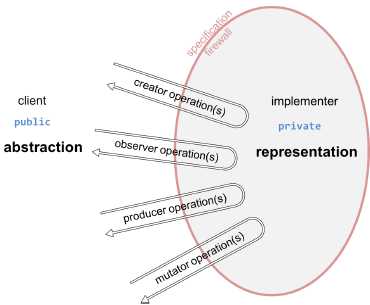
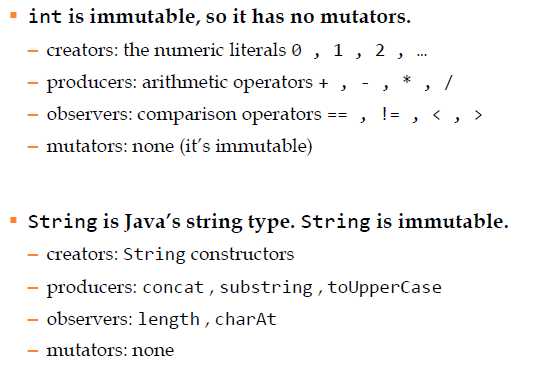
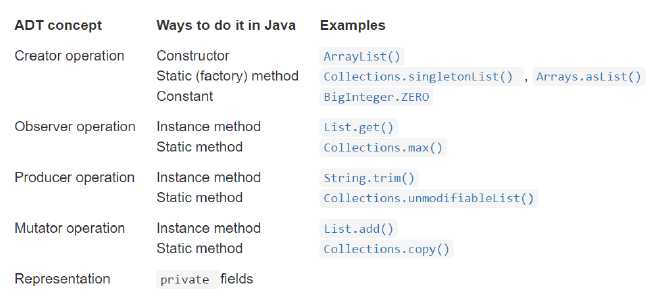
【设计一个好的ADT】
设计好的ADT,靠“经验法则”,提供一组操作,设计其行为规约 spec
【测试ADT】
【一个例子:字符串的不同表示】
让我们先来看看一个表示独立的例子,然后考虑为什么很有用,下面的MyString抽象类型是我们举出的例子。下面是规格说明:
1 /** MyString represents an immutable sequence of characters. */ 2 public class MyString { 3 4 //////////////////// Example of a creator operation /////////////// 5 /** @param b a boolean value 6 * @return string representation of b, either "true" or "false" */ 7 public static MyString valueOf(boolean b) { ... } 8 9 //////////////////// Examples of observer operations /////////////// 10 /** @return number of characters in this string */ 11 public int length() { ... } 12 13 /** @param i character position (requires 0 <= i < string length) 14 * @return character at position i */ 15 public char charAt(int i) { ... } 16 17 //////////////////// Example of a producer operation /////////////// 18 /** Get the substring between start (inclusive) and end (exclusive). 19 * @param start starting index 20 * @param end ending index. Requires 0 <= start <= end <= string length. 21 * @return string consisting of charAt(start)...charAt(end-1) */ 22 public MyString substring(int start, int end) { ... } 23 }
使用者只需要/只能知道类型的公共方法和规格说明。下面是如何声明内部表示的方法,作为类中的一个实例变量:
private char[] a;
使用这种表达方法,我们对操作的实现可能是这样的:
1 public static MyString valueOf(boolean b) { 2 MyString s = new MyString(); 3 s.a = b ? new char[] { ‘t‘, ‘r‘, ‘u‘, ‘e‘ } 4 : new char[] { ‘f‘, ‘a‘, ‘l‘, ‘s‘, ‘e‘ }; 5 return s; 6 } 7 8 public int length() { 9 return a.length; 10 } 11 12 public char charAt(int i) { 13 return a[i]; 14 } 15 16 public MyString substring(int start, int end) { 17 MyString that = new MyString(); 18 that.a = new char[end - start]; 19 System.arraycopy(this.a, start, that.a, 0, end - start); 20 return that; 21 }
执行下列的代码
MyString s = MyString.valueOf(true); MyString t = s.substring(1,3);
我们用快照图展示了在使用者进行 subString 操作后的数据状态:
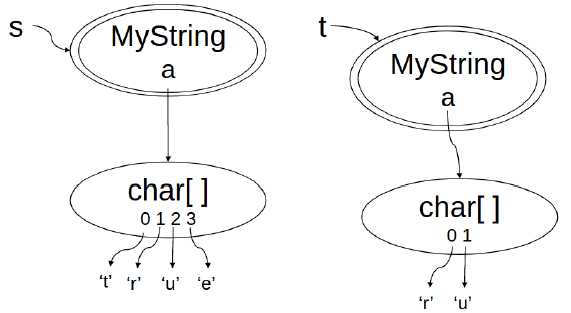
这种实现有一个性能上的问题,因为这个数据类型是不可变的,那么 substring 实际上没有必要真正去复制子字符串到?个新的数组中。它可以仅仅指向原来的 MyString 字符数组,并且记录当前的起始位置和终?位置。
为了优化,我们可以将这个类的内部表示改为:
private char[] a; private int start; private int end;
有了这个新的表示,操作现在可以这样实现:
1 public static MyString valueOf(boolean b) { 2 MyString s = new MyString(); 3 s.a = b ? new char[] { ‘t‘, ‘r‘, ‘u‘, ‘e‘ } 4 : new char[] { ‘f‘, ‘a‘, ‘l‘, ‘s‘, ‘e‘ }; 5 s.start = 0; 6 s.end = s.a.length; 7 return s; 8 } 9 10 public int length() { 11 return end - start; 12 } 13 14 public char charAt(int i) { 15 return a[start + i]; 16 } 17 18 public MyString substring(int start, int end) { 19 MyString that = new MyString(); 20 that.a = this.a; 21 that.start = this.start + start; 22 that.end = this.start + end; 23 return that; 24 }
现在运行上面的调用代码,可用快照图重新进行 substring 操作后的数据状态:
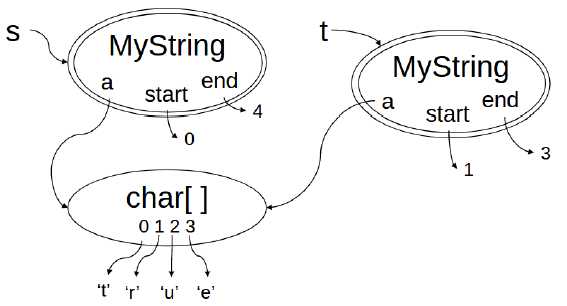
由于 MyString 的使用者仅依赖于其公共方法和规格说明,而不依赖其私有的存储,因此我们可以在不检查和更改所有客户端代码的情况下进行更改。 这就是表示独立性的力量。
一个好的抽象数据类型的最重要的属性是它保持不变量。一旦一个不变类型的对象被创建,它总是代表一个不变的值。当一个ADT能够确保它内部的不变量恒定不变(不受使用者/外部影响),我们就说这个ADT保护/保留自己的不变量。
【一个栗子:表示泄露】
1 /** 2 * This immutable data type represents a tweet from Twitter. 3 */ 4 public class Tweet { 5 6 public String author; 7 public String text; 8 public Date timestamp; 9 10 /** 11 * Make a Tweet. 12 * @param author Twitter user who wrote the tweet 13 * @param text text of the tweet 14 * @param timestamp date/time when the tweet was sent 15 */ 16 public Tweet(String author, String text, Date timestamp) { 17 this.author = author; 18 this.text = text; 19 this.timestamp = timestamp; 20 } 21 }
我们如何保证这些Tweet对象是不可变的,(即一旦创建了Tweet,其author,message和 date 永远不会改变)对不可变性的第一个威胁来自客户实际上必须直接访问其领域的事实。
标签:组件 作用 operation 数据类型 isp nbsp code 情况 分享图片
原文地址:https://www.cnblogs.com/hithongming/p/9132655.html